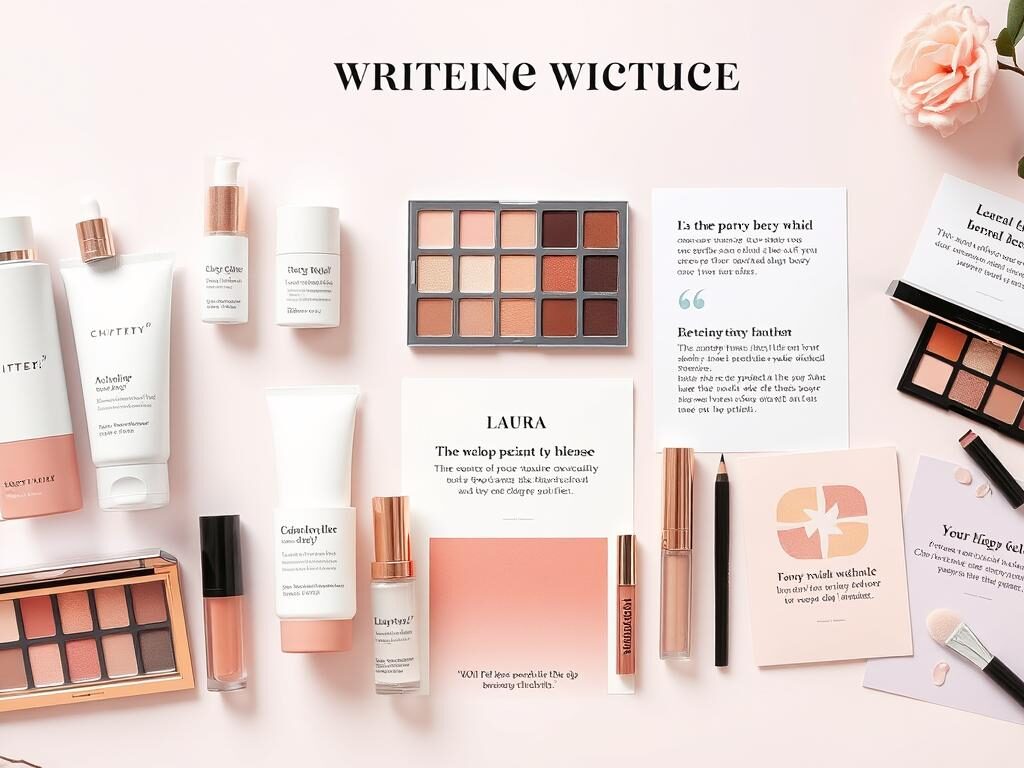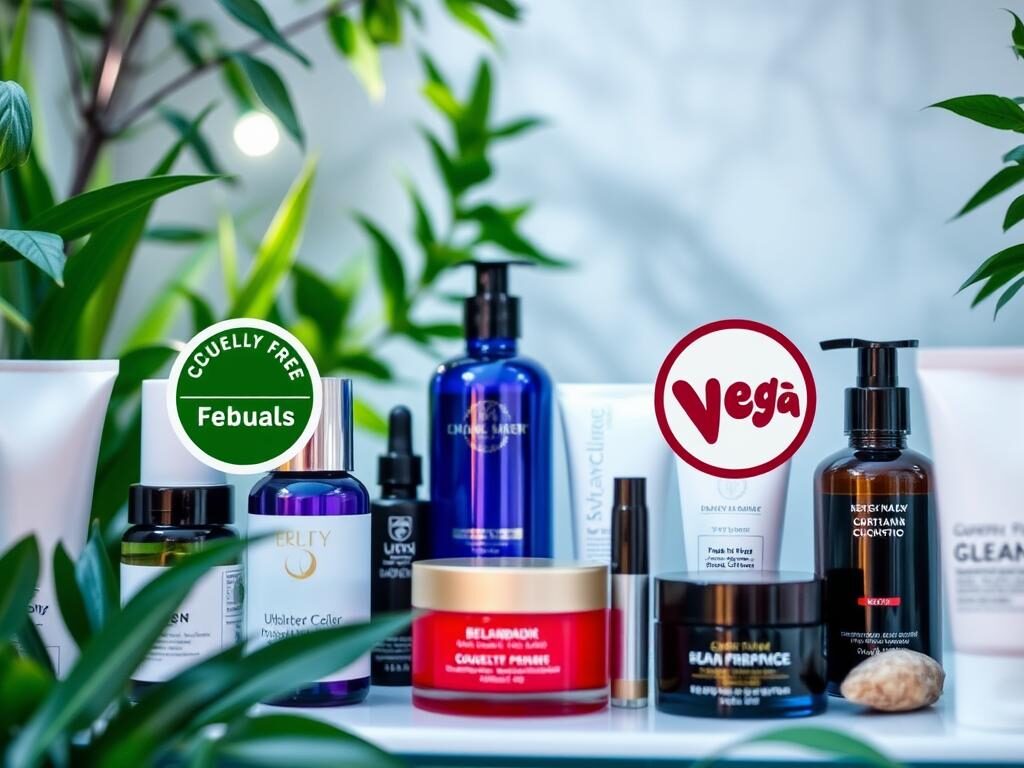Physical Address
304 North Cardinal St.
Dorchester Center, MA 02124
Physical Address
304 North Cardinal St.
Dorchester Center, MA 02124
As a conscious consumer in the beauty world, it’s key to know how to evaluate brands well. The beauty market keeps changing, focusing more on ethics, sustainability, and openness. By using a detailed set of standards, you can choose brands that match your values. This ensures you support companies that care about quality, safety, and doing good for society.
This article will guide you through the important parts of evaluating beauty brands. You’ll learn about the essential criteria, spotting ethical marks, and checking if products are open about what’s in them. With this info, you’ll be ready to pick the best beauty products. You’ll help your skin and support a greener, fairer world.

Exploring the world of beauty brands can feel overwhelming. Yet, knowing the evaluation standards is key. These standards help us see if a brand is open, ethical, and cares for the environment. These are the things that matter most to us.
At the core of evaluating beauty brands are several key points:
The beauty industry has long needed clear rules. Without them, it’s hard to trust brands. Standards help build trust, keep brands honest, and push for better products. Brands that follow these rules show they care about doing the right thing. This earns them the respect of shoppers who value honesty and ethics.
To judge beauty brands, we use specific metrics. These metrics help us check if brands are open about their ingredients, use eco-friendly packaging, and treat their workers right. By using these metrics, we can choose brands that share our values.
| Evaluation Metric | Description |
|---|---|
| Ingredient Transparency | The level of detail and clarity provided about the ingredients used in a brand’s products. |
| Ethical Sourcing | The brand’s commitment to fair labor practices and responsible procurement of raw materials. |
| Environmental Impact | The brand’s efforts to minimize its carbon footprint and promote sustainable packaging solutions. |
| Cruelty-Free Certification | The brand’s adherence to animal welfare standards and avoidance of animal testing. |
| Marketing Integrity | The truthfulness and accuracy of the brand’s advertising and product claims. |
By knowing and using these transparent brand evaluation standards, we can make better choices. We support brands that put ethics and the planet first in the beauty industry.
When looking for ethical beauty, it’s key to know the certifications and standards. These marks show if a brand follows ethical brand practices and vegan beauty guidelines. They help us find products that are both sustainable and cruelty-free.
PETA’s cruelty-free and vegan logos are well-known. They mean a brand’s products haven’t been tested on animals and don’t have animal parts. The Leaping Bunny logo, given by the Coalition for Consumer Information on Cosmetics, also shows a product’s supply chain is animal-test free.
Fair Trade certification is another important sign. It means workers get fair pay and work in safe, green places. Knowing these certifications helps us choose brands that care about people and the planet.
| Certification | Criteria | Significance |
|---|---|---|
| PETA Cruelty-Free and Vegan | No animal testing, no animal-derived ingredients | Ensures products are not tested on animals and do not contain any animal-based materials |
| Leaping Bunny | No animal testing in the entire supply chain | Guarantees a brand’s entire production process is free from animal testing |
| Fair Trade | Fair wages and safe working conditions for ingredient suppliers | Promotes social responsibility and environmental stewardship in the beauty industry |
Learning about these certifications helps us shop with confidence. We can make sure our choices match our values and help the beauty world become more sustainable.
“Sustainable and ethical beauty practices are no longer a luxury; they are a necessity for conscious consumers.”
Understanding what’s in your beauty products is key to making smart choices. By looking into the ingredients of your skincare, cosmetics, and personal care items, you can make better choices. This helps you stick to your clean beauty standards.
Some ingredients in mainstream beauty products are often questioned. These include parabens, phthalates, sulfates, and synthetic fragrances. They can cause health issues like endocrine disruption and skin irritation. As a mindful shopper, learn about these harmful additives and choose products without them.
Reading beauty product ingredient lists can be tough. But it’s essential for checking brand honesty. Look for lists that are clear and focus on natural, plant-based ingredients. The first ingredients listed are usually the main ones.
By focusing on product ingredient transparency, you can choose better. This supports brands that value honesty and ethics.
| Ingredient | Potential Concerns | Clean Beauty Alternatives |
|---|---|---|
| Parabens | Endocrine disruption, skin irritation | Preservatives like phenoxyethanol, potassium sorbate, or natural alternatives like rosemary extract |
| Phthalates | Hormone disruption, reproductive issues | Plasticizers like citrates or plant-derived alternatives |
| Sulfates | Skin irritation, dryness | Gentle surfactants like decyl glucoside or coco-glucoside |
| Synthetic Fragrances | Allergies, skin irritation | Essential oils or naturally-derived fragrance blends |
“Transparency is the foundation of trust, and trust is the foundation of any healthy relationship – whether personal or professional.”
Choosing ethical beauty products means knowing the difference between cruelty-free and vegan. Cruelty-free means no animal testing, while vegan means no animal products. It’s important to understand these labels to make choices that match your values.
Third-party groups like PETA or Leaping Bunny check if products are cruelty-free. They look at the brand’s making and who they work with. This ensures no animals are tested.
Vegan certification checks if products have animal parts like beeswax or honey. It’s about the ingredients. A detailed check makes sure the product is vegan.
| Cruelty-Free Verification | Vegan Certification |
|---|---|
| Ensures no animal testing | Ensures no animal-derived ingredients |
| Audits manufacturing and supply chain | Evaluates product formulation and sourcing |
| Certifications by PETA, Leaping Bunny, etc. | Certifications by Vegan.org, The Vegan Society, etc. |
When picking beauty products, look for cruelty-free verification and vegan certification. Knowing about these labels helps you choose ethically. It supports brands that care about animals and the environment.

“Ethical beauty is not just about the products we use, but the impact we have on the world around us.”
The beauty industry is changing, focusing more on sustainable packaging and lessening environmental harm. It’s key to check how a brand handles these issues to see if they’re truly ethical and sustainable.
Look for eco-friendly and recyclable materials in a brand’s packaging. Good choices include recycled plastics, glass, and biodegradable options like paper and bamboo. Stay away from single-use plastics, as they harm our planet.
It’s not just about the packaging. Check if a brand has clear environmental goals and is open about them. Look for USDA Organic or Leaping Bunny seals. Also, brands that share their carbon footprint and waste reduction efforts show they care about the planet.
| Packaging Material Standards | Environmental Commitment Indicators | Recycling Program Assessment |
|---|---|---|
| Post-consumer recycled plastics, glass, paper, bamboo | USDA Organic, Leaping Bunny certifications, carbon footprint disclosure, waste reduction efforts, renewable energy usage | Recycling or take-back programs, clear disposal and recycling instructions, accessible recycling process for customers |
By carefully checking a brand’s packaging and environmental efforts, you can choose wisely. This way, your beauty buys support brands that care about our planet. It’s all about making choices that match your sustainable beauty criteria and ethical beauty standards.
“Sustainable packaging is not just about the materials used, but also the entire lifecycle of the product – from production to disposal.”
When checking if a beauty company is ethical, look beyond what’s in their products and their ads. How they make their products is key to beauty industry ethics that caring consumers want.
To check a brand’s making practices, start by looking into where they get their ingredients. They should be open about where they get their main materials and how they get them. Good practices include fair trade, eco-friendly farming, and caring for the environment.
Then, see how they treat their workers. Do they pay fairly and keep their factories safe? Look for outside groups that say they treat workers well.
Also, check if they use green energy, reduce waste, and pack their products in eco-friendly ways. This shows their commitment to the planet.
“Transparency is key when it comes to understanding a brand’s true commitment to ethical manufacturing.”
By carefully checking a brand’s making practices, you can choose companies that really stand for beauty industry ethics you care about.

As conscious consumers, we must carefully check the marketing claims and how beauty brands talk to us. It’s important to look for honesty and openness in these interactions. By understanding what’s real in ads and how brands are open, we can make choices that match our values.
Beauty brands often make big claims about their products. But, transparent brand evaluation means looking past the flashy ads. Learn about the rules for honest advertising to spot any false claims.
A brand that values conscious consumer standards teaches its customers. Look for brands that share detailed info on ingredients, how they’re made, and their green efforts. This helps you make smart choices.
The real sign of a brand’s openness is how clear they are in their communication. Check if they show ingredient lists, have third-party checks, and answer customer questions well. These signs show a brand’s commitment to transparent brand evaluation and conscious consumer standards.
“Transparency is the new sustainability. Consumers want to know what they’re buying, where it came from, and how it was made.”
Keeping beauty products safe and of high quality is key. To keep your brand’s reputation strong, you need solid quality control steps. This includes strict product tests and safety checks. A careful approach to quality control can make your brand stand out in the clean beauty standards world.
Third-party testing and certification are vital for quality control. Trusted, outside groups can check if your products are safe and work well. This gives your customers the confidence they need. Look for brands that always test their products thoroughly, making sure they’re top-notch.
Putting quality control first shows you care about giving safe, effective, and reliable products. This not only keeps your customers coming back but also makes your company a leader in beauty brand evaluation standards and clean beauty standards.
Learning about beauty brand evaluation standards is key to making smart, ethical choices in the beauty world. You now know how to check if a brand is good, by looking at their ethics and what’s in their products. This helps you choose brands that care about the planet and animals.
When you support brands that are open, green, and fair, you help the whole industry grow better. Your buying habits can push brands to be more responsible and kind. This is a big deal for the beauty world.
Now, you can look at beauty brands in a new light. Your choices show what you value. By choosing wisely, we can create a beauty world that’s better for everyone and the planet. Your actions can really make a difference.
The main parts of beauty brand evaluation criteria are ingredient safety and ethical sourcing. Also, environmental responsibility, transparency in manufacturing, and following industry standards and certifications are key.
Beauty industry standards are key for those who care about the planet and animals. They ensure products are safe and made ethically. This helps you choose brands that match your values.
Look for logos like PETA’s cruelty-free and vegan signs, Leaping Bunny, and Fair Trade. These show a brand has been checked for ethical practices, like animal-friendly ingredients and fair labor.
Avoid parabens, phthalates, sulfates, formaldehyde, and synthetic fragrances. These are linked to health and environmental issues. They’re often found in regular beauty products.
Check for certifications from groups like PETA or the Vegan Society. These confirm a brand’s products and practices are animal-friendly and free from animal testing.
Look for packaging that’s recyclable, biodegradable, or compostable. Also, check if the brand is reducing their environmental impact, like through carbon offsetting or renewable energy.
Research where they get their ingredients, their labor policies, and how they produce. Look for transparency in their supply chain and ethical sourcing certifications. Also, check their commitment to fair labor and waste management.
Check if their ads are truthful and if they educate consumers. Look for transparency in their messaging and product info. This helps you make informed choices.
Quality control ensures products are safe, consistent, and work well. Look for brands that test their products thoroughly and follow safety standards. They should also be open about their quality assurance.